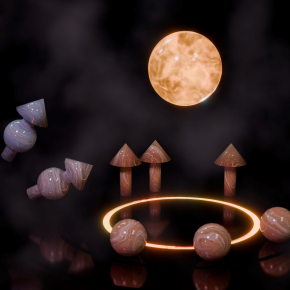Bosons Transformed into Anyons in a Quantum Gas
For the first time, "anyonic" behavior has been experimentally observed in a one-dimensional quantum gas. This breakthrough in quantum physics opens up new possibilities for studying exotic phases of matter as well as for topological quantum computing.
References :
Observing anyonization of bosons in a quantum gas, Sudipta Dhar, Botao Wang, Milena Horvath, Amit Vashisht, Yi Zeng, Mikhail B. Zvonarev, Nathan Goldman, Yanliang Guo, Manuele Landini, Hanns-Christoph Nägerl, Nature 642, 53–57 - Published 28 May 2025.
DOI : 10.1038/s41586-025-09016-9
In the quantum world, particles are classified into two major families: fermions, such as electrons or quarks, which make up matter, and bosons, such as photons or gluons, which mediate fundamental interactions. However, in systems with fewer than three dimensions, another family emerges: that of anyons—quasiparticles that are neither bosons nor fermions. Unlike ordinary particles, anyons do not exist in isolation; they emerge as collective excitations within a quantum state of matter. This phenomenon is reminiscent of phonons, which appear as collective vibrations in a solid but behave like distinct particles.
The present research was conducted in the following CNRS laboratories:
- Laboratoire Kastler Brossel (LKB, CNRS/Collège de France/ENS-PSL/Sorbonne Université)
Laboratoire de Physique Théorique et Modèles Statistiques (LPTMS, Université Paris-Saclay / CNRS)
Previously observed in two-dimensional systems, such as quantum Hall liquids, anyons had remained elusive in one dimension. An international collaboration of researchers from Austria, Belgium, and France has now overcome this challenge. Their results show that it is possible to “transmute” a boson into an anyon within a one-dimensional quantum gas, controlled with extreme precision. This work was published in the journal Nature.
The research team achieved this result by injecting and accelerating an impurity (a cesium atom) within a strongly interacting bosonic gas. By meticulously analyzing the momentum of the impurity, the scientists demonstrated that it mimics an anyonic particle, exhibiting unconventional quantum properties due to its intense coupling with the surrounding one-dimensional gas.
This experimental setup opens up new avenues for the study of anyons in highly controlled quantum gases. Beyond fundamental research, this result is particularly promising, as certain types of anyons are considered potential building blocks for topological quantum computing—a revolutionary approach that could overcome current limitations in quantum processors.
